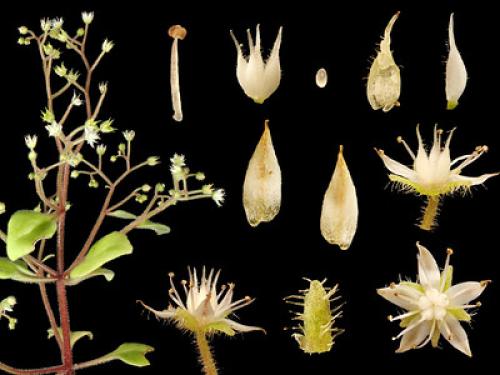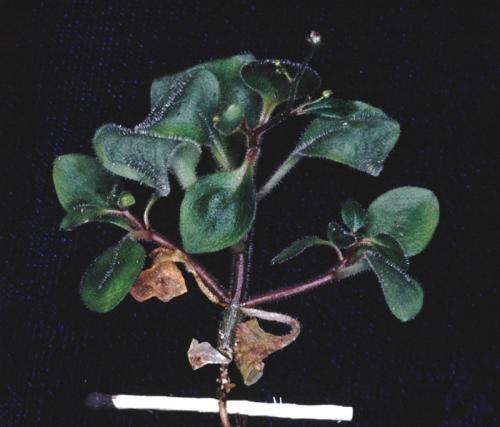DRYMARIOIDES Hance, 1865
Synonyms :
Sedum urayense hort. (s.a.)
Sedum uraiense Hayata (1916)
Sedum drymarioides var. genuinum Hamet (1924)
Sedum drymarioides var. toyamae H. Hara (1960).
Distribution : South-eastern China, Taiwan, Japan (Kyushu); on limestone.
Description (by 't Hart & Bleij in IHSP, 2003) :
Glandular-pubescent annual or biennial herbs with prostrate then erect stems to 20 cm tall, fleshy.
Leaves opposite or in whorls of 4, alternate in the upper stem parts, broadly ovate, obtuse, abruptly cuneate at the base, long-petiolate, 10 - 40 x 8 - 22 mm.
Inflorescences : Flowering branches ascending, slender, much branched, to 25 cm, inflorescences few-flowered lax panicles, pedicels slender.
FIowers 5-merous, sepals broadly sessile, oblong to broadly linear or lanceolate, obtuse to subacute, densely pubescent, to 2 mm, petals lanceolate or oblong, acute to acuminate, pubescent along the midrib, white, 3 - 4 mm.
Var. toyamae Hara differs from typical S. drymarioides by its denser indumentum and allegedly longer pedicels (see also Fröderström (1931)).
Ray Stephenson (Sedum, Cultivated Stonecrops, 1994, pp 158 - 159) :
Sedum drymarioides is unlike any other Oriental species in cultivation. Flat, entire, glan-dular-pubescent, opposite, spathulate leaves are noticeably stalked. The plant is very spindly and feeble, rising to 15 cm (6 in) high. In a warm greenhouse it can sometimes be persuaded to perpetuate for several seasons. Loose inflorescences carry white, pubescent flowers.
Habitat : Lowland southeast China and Taiwan are the home of the type species, but Sedum drymarioides var. toyamae (?) is reported from southern Japan.
Main points of distinction : Plants could not be confused with any other species in cultivation. The soft, hairy, petiolate-spathulate leaves are not particularly succulent, but they are unique in the genus. All flower parts, except carpels, are pubescent. Carpels remain quite upright, and petals only partly open to about 60°. Blackish seeds are large for Sedum, being about 0,5 mm (0,02 in) long.
Variation : Unable to comment.
Horticulture : This species is best grown on a heated tray full of sandy material near an open door. It is of little horticultural importance, but if a small colony can be perpetuated, the resulting display is certainly different and can give much pleasure to the grower.

Photo by taiwanicus
